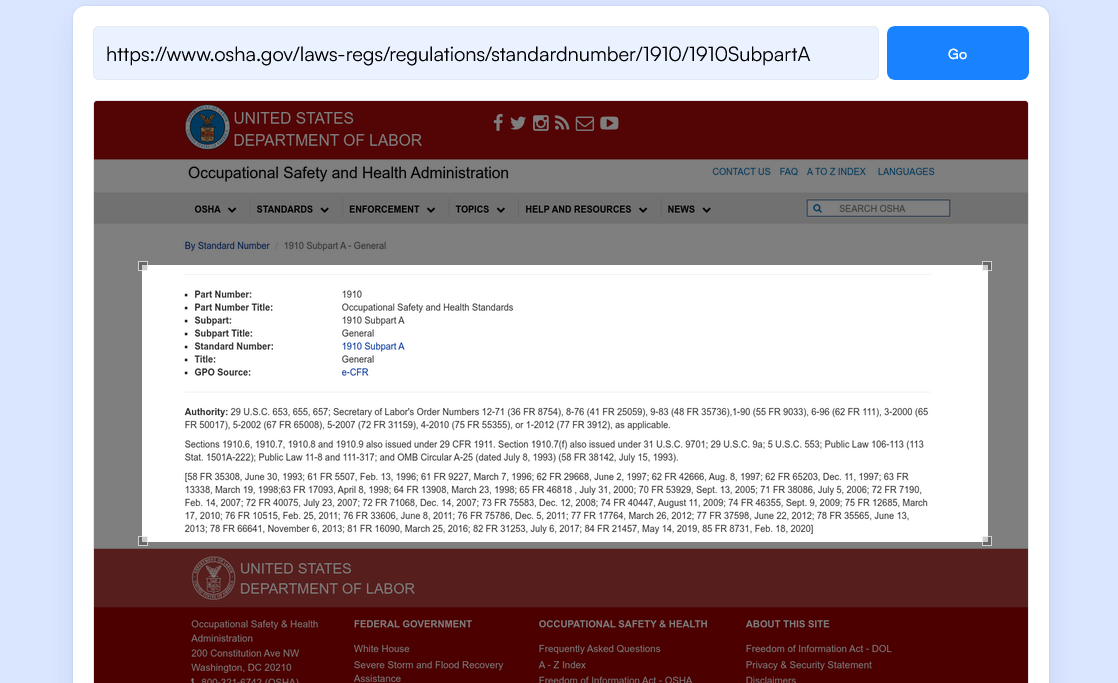Guide to Creating a Compliance Monitoring Plan - Visualping
By Emily Fenton
Updated February 27, 2023

Guide to Creating a Compliance Monitoring Plan
Every business is governed by a collection of federal and state regulations. These regulations stand to protect consumers and employees alike, and they help ensure that your business is functioning as it should. Still, following these regulations is a process that is much easier said than done.
A single business may be required to follow thousands of specific laws and other regulations, many of which change on a daily basis.
To avoid accidental violations, every business needs to stay abreast of regulatory changes and revise company policies and procedures when necessary, a process called compliance monitoring.
Compliance monitoring can seem like a massive challenge and an all-around headache at first, but with a detailed, business-wide plan, and simple yet powerful compliance monitoring tools like Visualping, you’ll be able to keep up with regulatory changes and ensure your company remains compliant.
Here’s a look at how to create and stick to a compliance monitoring plan.
The Importance of Compliance Monitoring
Monitoring Laws and Regulations
Before getting started on developing your compliance monitoring plan, it’s important to understand exactly what compliance monitoring is, and why it’s important.
In a nutshell, compliance monitoring involves tracking new and upcoming changes in industry-specific laws and regulations. It enables the implementation of internal practices and protocols to ensure every branch of your business remains compliant with those ordinances.
Some industries are subject to more regulations than others, such as the finance and pharmaceutical industries, which face frequently shifting expectations. Some industries also need to stay on top of state, federal and international laws and regulations.
Additionally, some regulations apply to all businesses, while others are industry or geographically-situated. Some broadly applicable examples of regulatory compliance include the following:
- Following anti-discrimination policies as laid out by the Equal Employment Opportunity Commission (EEOC)
- Making sure wages meet or exceed the federal minimum wage specified by the Fair Labor Standards Act (FLSA)
- Ensuring compliance with worker safety rules defined by the Occupational Safety and Health Administration (OSHA)
Monitoring Software Licenses
You may also need to navigate complex licensing agreements to ensure your own compliance, and mitigate risks associated with software audits. You can do so manually, or with AI web monitoring tools, or with the help of ai services, for expert guidance.
Most businesses in heavily-regulated industries form specialized compliance departments that are responsible for monitoring regulatory changes, designing compliance protocols, and making sure those protocols are being followed on a daily basis, but regardless of whether yours has a dedicated compliance department, your business should have a clear protocol for internal compliance monitoring.
With consistent monitoring, you’ll be able to make sure employees are following all company rules and protecting the safety and confidentiality of your customers.
Creating an Internal Compliance Monitoring Plan
As you prepare to create a compliance monitoring plan, it can be hard to know where to start. Below is a comprehensive five-step framework to help you develop compliance monitoring policies for any type of business.
Conduct a Regulatory Compliance Audit
Before you get started on a new monitoring plan, take a look at two things: your primary compliance risks and your current compliance protocols. Investigate and document both as thoroughly as you can. The more comprehensive your internal audit is, the more effective your improved compliance plan will be.
Identify and Focus on the Areas of Highest Risk
Compliance risks can look drastically different depending on the industry in question. For instance, regulatory compliance in banking sector applications will look completely distinct from IT compliance monitoring. Therefore, before determining which areas pose the highest compliance risk, make sure you get a comprehensive picture of all the rules and regulations that apply to your specific industry.
If you haven’t created a compliance monitoring plan before, identifying major risks can be difficult, but it is a critically important part of any monitoring plan. Don’t be afraid to enlist expert help if you need to. Once you’ve recognized the prominent dangers, prioritize them in your monitoring plan. You’ll want to rigorously monitor all of them to minimize your chances of violations.
Automate Your Regulatory Monitoring Processes
Tracking regulatory changes by reading (and re-reading) updates from the legislative government, or announcements from regulatory agencies, is difficult or impossible -- especially for large businesses in highly-regulated industries.
You can leverage a simple regulatory intelligence software, like Visualping, to automatically check the relevant web pages for you, and notify you when there's a change.

Visualping is a powerful yet easy-to-use tool that automatically checks regulatory websites for you, at the frequency you specify. It offers real-time regulatory change alerts, for urgent updates you need to know about right away.
There’s no limit to the number of sites you can track. Monitor as many pages as your compliance monitoring plan dictates, so you'll always be in the loop when it comes to regulatory and legislative changes in your industry.
Create Robust Compliance Reporting Protocols
Compliance reporting isn’t just important as a means of avoiding violations; it’s also a critical element of maintaining company integrity and ensuring your compliance monitoring plan is being followed.
With compliance reporting, more documentation is always better. A good report will include an issue (like an employee complaint), what was done to deal with it, and its resolution. Your reporting protocol should clearly indicate who is responsible for compiling reports, how those reports will be organized and stored, and who can access them.
In especially larger companies, however, the sheer volume of compliance reports can quickly become unmanageable if they are created and stored in hard-copy form. In most cases, implementing compliance software to keep reports organized, searchable, and easily accessible is the best option.
Monitor the Effectiveness of Your Compliance Initiatives
Once new compliance initiatives have been put into place, it’s easy to assume that the planning process is complete, but constant monitoring is essential, as keeping track of compliance initiatives helps you identify potential gaps and take corrective action before any small problems become catastrophic.
With that being said, the most effective way to monitor your compliance initiatives is to designate and track key performance indicators (KPIs), metrics you can track over time that assess how well your compliance initiatives are working.
Here are a few examples of KPIs:
- Employee complaints
- Customer or client complaints
- How long it takes to discover issues
- How long it takes to resolve those issues
- Violations of laws and regulations
When tracking these, it’s important to find and collect as much data as possible. For example, when tracking employee complaints, don’t just track how many employees made complaints: Look at the allegations they’ve made (and whether those allegations are substantiated), whether they complained anonymously or directly to a supervisor, and whether the issue was resolved in a timely manner.
Enlist Subject Matter Experts for Specialist Knowledge and Insight into Specific Sets of Risks
Throughout many industries, there are thousands of laws and regulations that businesses need to adhere to, many of which are incredibly specific and therefore, likely difficult for most to understand. In these cases, it’s in your best interests to hire a subject matter expert, both to clarify regulations and determine which ones pose the greatest compliance risks to your business.
For instance, regulatory intelligence in pharmaceutical industry applications require an analyst with a deep understanding of that particular industry. Tracking changes in regulations may be one part of the puzzle, but an expert can help your business develop an actionable plan to ensure ongoing compliance.
Make Compliance Monitoring Simpler than Ever
Once you’ve implemented an internal compliance monitoring plan, all you need to do is make sure your business continues to follow it. That all starts with making sure you know about regulatory changes as soon as they happen.
When you use Visualping for Business, you’ll never be left in the dark. Once you create an account, you can start monitoring in a matter of minutes. Our helpful and knowledgeable team is always here to answer any questions you may have, so get in touch with us today to get started with Visualping.
Want to stay on top of non-compliance?
Sign up with Visualping to detect issues from any web page online – before your business is on the line.
Emily Fenton
Emily is the Product Marketing Manager at Visualping. She has a degree in English Literature and a Masters in Management. When she’s not researching and writing about all things Visualping, she loves exploring new restaurants, playing guitar and petting her cats